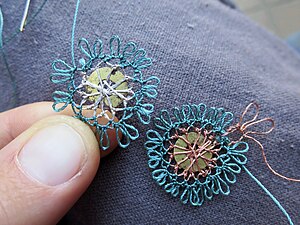| This article needs additional citations for verification. Please help improve this article by adding citations to reliable sources. Unsourced material may be challenged and removed. Find sources: "Oya" lace – news · newspapers · books · scholar · JSTOR (February 2017) (Learn how and when to remove this message) |


Oya, “Turkish lace”, is a Turkish word that means various forms of narrow lace trimmings, that is worn throughout the eastern and southern parts of the Mediterranean region, as well as Armenia. It is thought to date back as far as the 8th century BC, to the Phrygians of Anatolia. Some argue that the needlework and the decorate edging spread from 12th century Anatolia to Greece and from there via Italy to Europe. Oya appears in various forms and motifs, with the most beautiful examples made by aristocratic, urban and experienced women in the Ottoman palace. Today, it is still very popular among the Turkish elite and is highly sought after and very collectible. The craft of oya is a unique language for Turkish women.
Oya is used on headdresses and scarves of women, undergarments and outer garments alike, and frequently on household textiles, such as the edges of towels, napkins, and table cloths; in the Aegean Region even men’s headdresses were decked with layers upon layers of oya. Modern oya is also used in jewelry making. The basic types include the needle made oya (usually three-dimensional), the crochet oya and the hairpin oya. It is often combine with beads, sequins and other decorative pieces.
Young girls, new brides traditionally conveyed their love, hopes, expectations and happiness through the oya they wore. Many motifs are inspired by nature, usually the flowers and fauna found in the Turkish countryside. As the craft evolved, various motifs began to take on certain symbolic meaning, almost like a secret language between the women. For example, women would wear oya with different flowers depending on their age; older women wore tiny wild flowers while young women and brides wore roses, jasmine, carnations, violets, fuchsia; yellow daffodils signified hopeless love; a wife whose husband had gone abroad to work would warp wild rose oya around her head; a girl in love wore purple hyacinths. By the 21st century, machine-made oya is available for sale, but is not as popular as the handmade version, thought to be more “alive”.
References
- "Oya: A Traditional Needle-Lace Embellishment". PieceWork. Retrieved 2024-09-15.
- Travellers in Ottoman Lands: The Botanical Legacy. Archaeopress. 2018. doi:10.2307/j.ctv1nzfwbx.28. JSTOR j.ctv1nzfwbx.
- "Oya, The Ancient Art of Needle Lace | Creative Knitting Blog". Creativeknittingmagazine.com. 2012-03-08. Retrieved 2017-02-23.
- "Oya (Turkey)". Trc-leiden.nl. Retrieved 2017-02-23.
- "Oya, The Language of Anatolian Women". Turkishculture.org. Retrieved 2017-02-23.
| Lace types | |||||||||
|---|---|---|---|---|---|---|---|---|---|
| Needle lace |
|  | |||||||
| Bobbin lace |
| ||||||||
| Tape lace | |||||||||
| Crocheted lace | |||||||||
| Machine-made lace | |||||||||
| Other handmade laces | |||||||||